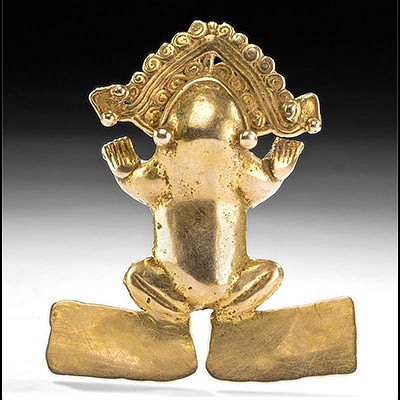Spectacular Teotihuacan Pottery Theater-Type Censer Lid
Lot 105
About Seller
Artemis Fine Arts
686 S Taylor Ave, Ste 106
Louisville, CO 80027
United States
Selling antiquities, ancient and ethnographic art online since 1993, Artemis Gallery specializes in Classical Antiquities (Egyptian, Greek, Roman, Near Eastern), Asian, Pre-Columbian, African / Tribal / Oceanographic art. Our extensive inventory includes pottery, stone, metal, wood, glass and textil...Read more
Categories
Estimate:
$8,000 - $12,000
Absentee vs Live bid
Two ways to bid:
- Leave a max absentee bid and the platform will bid on your behalf up to your maximum bid during the live auction.
- Bid live during the auction and your bids will be submitted real-time to the auctioneer.
Bid Increments
| Price | Bid Increment |
|---|---|
| $0 | $25 |
| $300 | $50 |
| $1,000 | $100 |
| $2,000 | $250 |
| $5,000 | $500 |
| $10,000 | $1,000 |
| $20,000 | $2,500 |
| $50,000 | $5,000 |
| $100,000 | $10,000 |
| $200,000 | $20,000 |
About Auction
By Artemis Fine Arts
Aug 13, 2020
Set Reminder
2020-08-13 10:00:00
2020-08-13 10:00:00
America/New_York
Bidsquare
Bidsquare : Fine Antiquities, Ethnographic & Fine Art
https://www.bidsquare.com/auctions/artemis-gallery/fine-antiquities-ethnographic-fine-art-5415
Features classical antiquities, ancient and ethnographic art from cultures encompassing the globe. Egyptian, Greek, Roman, Etruscan, Near Eastern, Asian, Pre-Columbian, Native American, African / Tribal, Oceanic, Spanish Colonial, Russian, Fine Art, so much more! Artemis Fine Arts info@artemisgallery.com
Features classical antiquities, ancient and ethnographic art from cultures encompassing the globe. Egyptian, Greek, Roman, Etruscan, Near Eastern, Asian, Pre-Columbian, Native American, African / Tribal, Oceanic, Spanish Colonial, Russian, Fine Art, so much more! Artemis Fine Arts info@artemisgallery.com
- Lot Description
Pre-Columbian, Mexico, Teotihuacan, ca. 500 to 700 CE. A dramatic theater-type censer lid, the base of a conical form with an upper decorative sculptural work similar to the architectural entablature of Teotihuacan temples. Censors like this are called theater-types, because the masked "face" hidden behind a nose ornament with earspools seems to be looking out from a stage surrounding a proscenium adorned with symbols. This example features four round adornos representing flowers (three above and one below the visage) and a row of three trios of feather motifs on rectangular panels called mantas. Some scholars have argued that the central mask represents the Teotihuacan Goddess due to the butterfly symbolism that oftentimes accompanies it and the nosebar. In the figure's right hand is a feather-adorned blade with motifs similar to the upper plumes. Size: 16.875" W x 19.5" H (42.9 cm x 49.5 cm)
Given the repeated depictions of masks in various media - mural painting, statues, and incensarios lids like this one, scholars have concluded that masks played an important role in Teotihuacan rituals. This example presents distinct indications of elite rank and status such as prominent earspools and that wonderful nose ornament. Due to the shape of the nose or mouth ornament, scholars have suggested that it represents a Teotihuacan talud-tablero temple. This form, oftentimes featured in theater-type censers, was also associated with butterfly symbolism. According to scholar Annabeth Headrick, Sejourne first made the association of the nose plaque with the butterfly in 1962, and Caso agreed to label it by its Nahautl name, yacapapalotl in 1966. Adding further support to this was von Winning who argued it was associated with the "Butterfly God" (1987), and Kubler (1972) and von Winning (1987) associated butterflies with the deceased. (The Teotihuacan Trinity: The Sociopolitical Structure of an Ancient . . ." by Annabeth Headrick, University of Texas Press, 2007)
Such ceramic censers were used to burn fragrant incense. According to Berrin and Pasztory, "Copal was placed in the bowl of the flower-pot-shaped vessel which was elevated on another inverted flower-pot-shaped vessel. It was covered by a conical lid; through the back rose a chimney like tube where the smoke escaped. The emphasis is not on the function of the vessel but on the scene that had been constructed on top and the images and ideas it was meant to convey." (Teotihuacan Art From the City of the Gods, edited by Kathleen Berrin and Esther Pasztory, Thames and Hudson: The Fine Arts Museums of San Francisco, 1993, p. 216)
Compare to a similar example published in "Teotihuacan Art From the City of the Gods," edited by Kathleen Berrin and Esther Pasztory, Thames and Hudson: The Fine Arts Museums of San Francisco, 1993, p. 217. Another useful source is, "The Teotihuacan Trinity: The Sociopolitical Structure of an Ancient . . ." by Annabeth Headrick, University of Texas Press, 2007.
Provenance: Whisnant Gallery, New Orleans, Louisiana, acquired prior to 1997
All items legal to buy/sell under U.S. Statute covering cultural patrimony Code 2600, CHAPTER 14, and are guaranteed to be as described or your money back.
A Certificate of Authenticity will accompany all winning bids.
We ship worldwide and handle all shipping in-house for your convenience.
#123339Repaired from numerous pieces with many losses as shown, nevertheless the surviving piece would make a fabulous centerpiece for any serious collection. Missing several adornos and left hand which probably held an object similar to that in the right hand. Surface still shows red and yellow pigment.Condition
- Shipping Info
-
All shipping is handled in-house for your convenience. Your invoice from Artemis Gallery will include shipping calculation instructions. If in doubt, please inquire BEFORE bidding for estimated shipping costs for individual items.
-
- Buyer's Premium



 EUR
EUR CAD
CAD AUD
AUD GBP
GBP MXN
MXN HKD
HKD CNY
CNY MYR
MYR SEK
SEK SGD
SGD CHF
CHF THB
THB
















